Nestled in the rolling hills of Tuscany’s Maremma region, between the shimmering Mediterranean coast and the rugged Metalliferous Hills, lies Rocca di Montemassi. Spanning 430 hectares—105 of which are dedicated to vineyards—this estate, acquired by the Zonin1821 group in 1999, is a portrait of modern winemaking rooted in tradition. Here, sun-drenched days tempered by coastal breezes and soils rich in iron and clay shape a viticulture that’s bold, expressive, and mineral.
We sat down with Alessandro Gallo, a winemaker from Piedmont and director of the estate, to explore how Rocca di Montemassi is rethinking sustainability—not just in the vineyard, but across its entire agricultural ecosystem.
“We’re not just a winery. We’re a wine farm,” says Gallo.

Born and raised in Piedmont, Gallo began working with the Zonin group in 2004 at Castello di Albola in Chianti. In 2016, he also took the helm at Rocca di Montemassi. “Both estates are in Tuscany, but they couldn’t be more different—soils, climate, grape-growing potential—everything,” he explains.
That contrast has given Gallo the freedom to innovate. Unlike Chianti, with its stricter DOCG rules, Maremma offers more flexibility.“Here, we can experiment more freely with grape varieties and wine styles. We focus mainly on international reds like Cabernet, Merlot, and Syrah, often blended, along with a small amount of Sangiovese. For whites, it’s Vermentino—which thrives in this region—and Viognier.”
From day one, Gallo envisioned a holistic, integrated farming model where every piece of the estate supports the others. “We began the transition to organic in 2016 and completed it in 2021. But our real leap was in designing Rocca di Montemassi as a true wine farm—a complete agricultural system that prioritizes local production, reduces waste, and enhances biodiversity.”That vision is now visible across the property. Alongside the vineyards are olive groves, wheat fields, pastures for native Maremmana cattle, and a wine tasting room.
“Our goal is to build an agricultural ecosystem that regenerates local resources and nurtures biodiversity. For instance, we plant fava beans between vineyard rows in the fall and plow them under in the spring to enrich the soil. The cows’ manure becomes fertilizer. We use no synthetic chemicals. It’s a closed, circular system that touches every corner of the farm.”
“It’s a closed, circular system that touches every corner of the farm.”
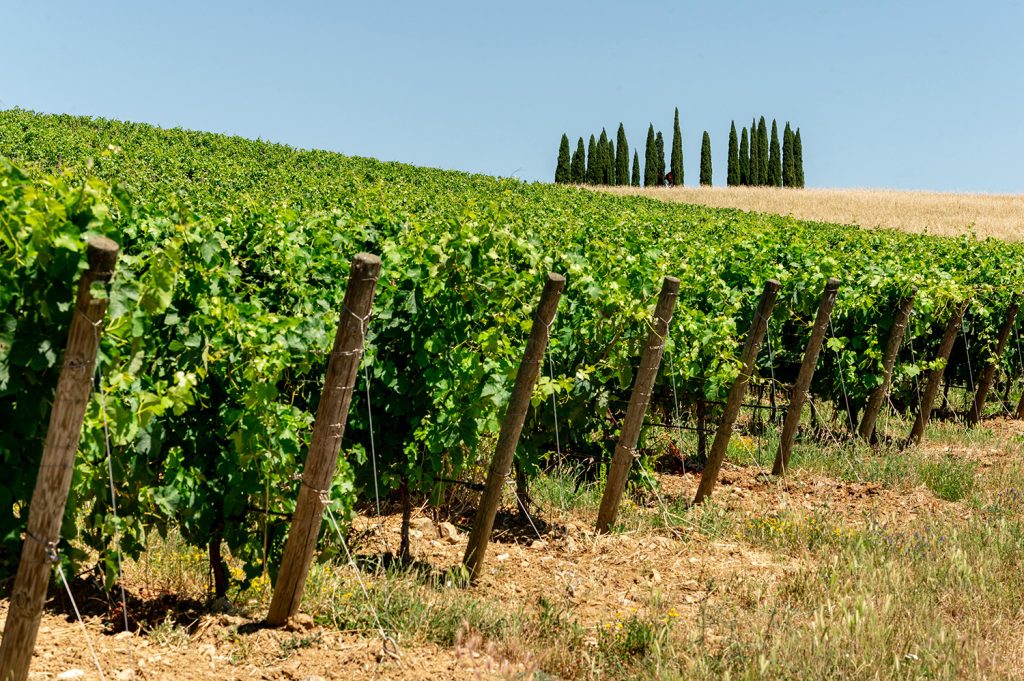
Smart tech for transparent sustainability
The Role of Digital Innovation
At Rocca di Montemassi, sustainability is as much about data as it is about field work. The team has embraced cutting-edge tools to support their goals.
“We’ve invested in recovery sprayers that minimize copper and sulfur loss during treatments. And since 2018, we’ve been using Vintel, a decision support system for irrigation planning” says Gallo.
“Vintel helps us irrigate precisely, based on both plant needs and our winemaking goals. It’s a big part of reducing our water footprint.”
He adds : “Using the platform, we can monitor the water status of each vineyard block and irrigate only when necessary—keeping vines in their sweet spot for optimal expression.”
“Vintel helps us irrigate precisely, based on both plant needs and our winemaking goals. It’s a big part of reducing our water footprint.”
Transparency Through Certification
To back up their sustainability claims, Rocca di Montemassi joined the italian Equalitas Sustainability Certification program in 2018. This gives them a structured way to track, measure, and report their environmental, social, and economic impact annually.

Telling the story: Wine tourism as an ally of sustainable wine making
The estate is also home to the Museum of Rural Civilization, housing more than 3,000 tools and photographs that tell the story of traditional Tuscan farm life. It’s a tribute to the butteri, the region’s traditional cattle herders.
“The winery tasting room and museum are essential parts of the farm experience” says Gallo. “They help visitors truly understand what it means to make wine sustainably, with respect for land and history.”Wine tourism, he believes, is a key ally in agroecological transition. “It creates both cultural and economic value rooted in the territory.”
Climate change, markets, and the road forward
Like many farms in southern Europe, Rocca di Montemassi is facing the challenges of climate change.“We’re seeing shifts in rainfall patterns and more frequent droughts. We have to rethink our grape varieties and how we manage the vineyards. Adaptation and planification are crucial” .”
But the challenges aren’t just environmental. “The market is changing, too. Consumers are more demanding, and global competition is fierce. That’s why we focus on quality, identity, and innovation.”
In short, Rocca di Montemassi is betting on a future where great wine comes from resilient farming, smart tools, and storytelling.
“We need to stay flexible, make smart decisions, and create value across the board,” Gallo concludes. “For us, innovation and sustainability aren’t just buzzwords—they’re how we plan to thrive.”
“We need to stay flexible, make smart decisions, and create value across the board”
Contact us now and ask for a demo!

The Masseria Altemura estate
Nestled in the heart of Puglia, in the south of Italy, Masseria Altemura lies halfway between two seas, enjoying cool sea breezes from the Ionian and saline air the Adriatic.
The estate, acquired by the Zonin1821 group in 2000, covers 140 hectares of vineyards set in a unique terroir. The soils, a blend of rock and clay, paired with a Mediterranean climate—hot, dry summers and mild winters—create the perfect environment for high-quality viticulture. The estate hosts a variety of prestigious grape varieties, including local gems like Aglianico and Primitivo.
Since 2005, the estate has been under the watchful eye of Antonio Cavallo, the vineyard manager and winemaker. A native of Puglia with a degree in Agricultural Sciences from Bologna, Antonio brings a no-nonsense mix of traditional know-how and scientific curiosity to his work. “My goal,” he says, “has always been to let the native varieties speak for themselves—while giving them the right tools to do it.” explains Antonio “It’s about taking everything into account: from the climate and soil to the style of wine —every detail guides our decisions in the vineyard.”
Antonio gives us a picture of the estate vineyards: “Around 70% of the vineyards are planted with reds, with Primitivo making up about half of our production. We also grow Aglianico and Malvasia Nera. For white grapes, we have Malvasia, Fiano, Moscato, and Falanghina.” Yields vary depending on the variety: “For Primitivo, we are around 70-80 quintals per hectare, while for Fiano and the rosé production, yields are a bit higher, around 110.”
“My goal, has always been to let the native varieties speak for themselves—while giving them the right tools to do it “.

A changing climate
Like many growers across southern Europe, Antonio has watched the local weather patterns slip out of sync. “Rain is coming at the wrong times, and it’s not just a few days—it’s entire seasons that look nothing like they used to,” he says. Take spring 2023, for example: humid, wet, and unpredictable, it ushered in one of the worst downy mildew seasons in recent memory of the region, which is not usually exposed to high disease pressures. “But luckily we were not affected” Antonio says “We were prepared. We acted fast, monitored closely, and protected the fruit.”
Warmer winters are also accelerating vine growth. “This year Moscato budded in early March,” he says “and within two weeks we were at two leaves. This precocity makes vines vulnerable to spring frost damage—a risk that used to be rare here.”
« This (phenological) precocity makes vines vulnerable to spring frost damage—a risk that used to be rare here. »
An irrigation strategy tailored to each variety
According to Antonio, the key to resilience is precision. Masseria Altemura uses a drip system which is triggered only when vines are exposed to real water stress—what is called ‘rescue irrigation.’ It’s a system designed for a region where the dry, hot summers can quickly turn punishing. “The idea isn’t to irrigate routinely,” he explains, “but to act when the vines actually need it—and in a way that fits the character of each variety.”
The Mediterranean climate—with its long, dry, and sun-soaked summers—offers both a challenge and an opportunity for viticulture. In the ripening season, when rainfall is scarce, irrigation becomes not just a support, but a strategic tool. “At that point, the vines rely almost entirely on us,” says Antonio. “And that means we can adjust irrigation to obtain a certain wine style.”
At Masseria Altemura, irrigation isn’t about simply quenching thirst—it’s a fine-tuned balancing act. Strategies are tailored to each grape variety, guided by the wine style they aim to achieve and informed by weather patterns and lessons from previous harvests. “If one year we ended up with overly tannic musts or yields that were too low, the following season we make adjustments to ease a bit more the water stress,” Antonio explains.
Precise water management is essential—not only to maintain the vine’s vegetative balance, but to shape wine style itself. “Every variety reacts differently to water, to stress, to the rhythm of the season” Antonio emphasizes. “Understanding the water behavior of each variety is key to striking the right balance between vigor and ripening, and create good wines”.
Over time, they’ve built detailed irrigation profiles for each grape. For example, white varieties are protected from excessive water stress to preserve their freshness and minerality. “For reds, we can stress a bit more, but it depends,” he says. “Negroamaro, for example, has very little resilience to drought—once it’s stressed, it hardly recovers. So, we make sure it never crosses that stress threshold. Primitivo, on the other hand, has delicate skins, so we pay very close attention not to water in excess in the last two weeks before harvest, to avoid berry splitting.”
“Everything comes back to knowing how each variety behaves under pressure,” Antonio adds. “That knowledge is what lets us guide the vine—and the wine—in the right direction.”
« Understanding the water behavior of each variety is key to striking the right balance between vigor and ripening, and create good wines. »
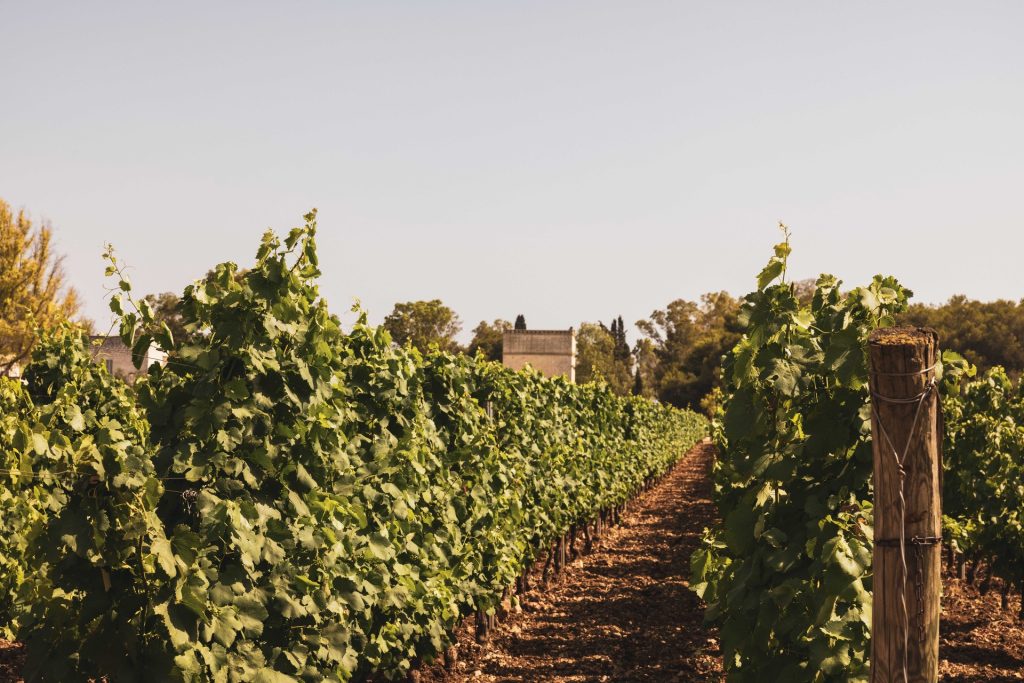
From manual to digital
Such precision might seem difficult to achieve, but for years, the estate has been fine-tuning its water management practices with monitoring tools like the pressure chamber. This device measures leaf water potential—the pressure needed to draw water from a leaf—providing a direct indicator of the vine’s hydration status. Unlike soil moisture sensors, this method offers a plant-centered perspective, especially valuable in viticulture. Yet, it’s a technique that demands experience and manual effort, requiring daily dedication to maintain consistent monitoring.
“When I first arrived in 2005,” Antonio recalls, “given the size of the estate, measuring leaf water potential throughout the summer meant having one person working full-time for three straight months.”
That’s why, since 2018, the estate has adopted Vintel®, a decision support system for precision irrigation. Vintel® offers daily simulations and forecasts of leaf water potential, making vineyard monitoring more accessible and strategic. From the beginning, it proved to be an ideal partner for Masseria Altemura’s approach. The platform is powered by multifactorial agronomic models that consider soil, climate, grape variety, and winemaking objectives, tailoring its recommendations accordingly.
Thanks to this integration, the estate now benefits from highly accurate water stress forecasts, drastically reducing the need for manual measurements. The result is a streamlined, time-efficient process that doesn’t compromise on quality.
“Today, thanks to Vintel®, we can simulate and forecast leaf water potential with precision,” Antonio explains. “We only use the pressure chamber to confirm the data. It lets us work more efficiently—and with greater peace of mind.”
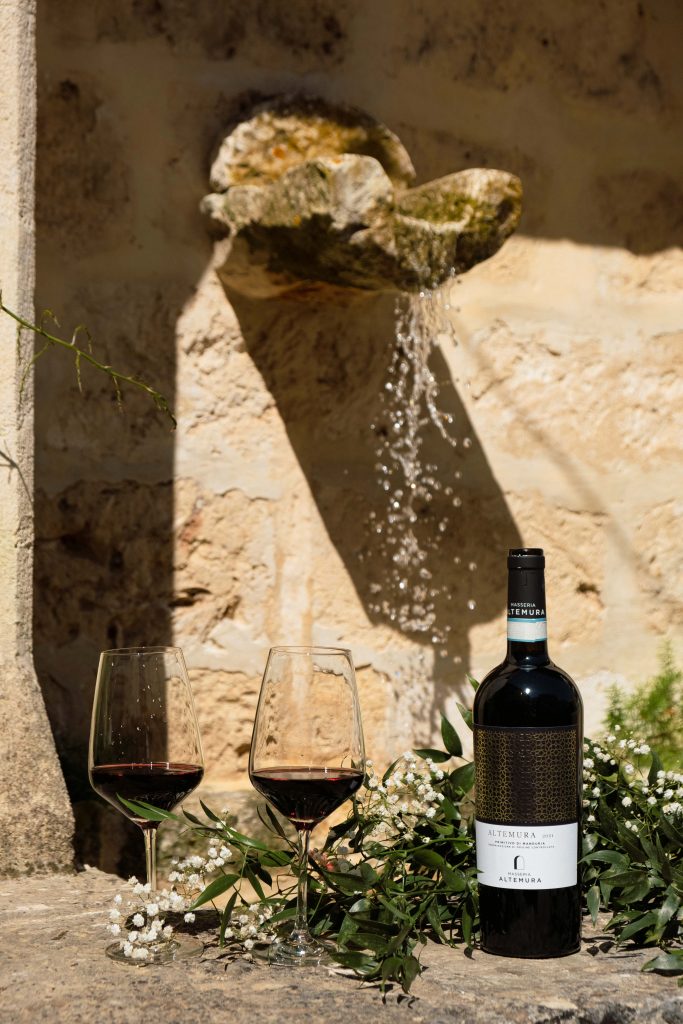
« Today, thanks to Vintel®, we can simulate and forecast leaf water potential with precision [..] . It lets us work more efficiently—and with greater peace of mind. »
Innovation, Sustainability, and Terroir
Masseria Altemura stands as a prime example of how thoughtful agronomic management and innovation can meet today’s viticultural challenges—enhancing the potential of a unique terroir while ensuring sustainability and resilience.
That path, however, hasn’t always been smooth. “In the beginning, there was a lot of trial and error,” Antonio admits. “It took time and effort to calibrate the DSS, to define irrigation strategies and the water response profiles of each variety.”
And each year, the challenge begins anew. As climate patterns shift and conditions evolve, strategies must be constantly reassessed. What worked one year may no longer apply the next. But at Masseria Altemura, years of field experience, combined with a data-driven approach, have shaped a resilient and adaptable system—one that not only navigates uncertainty but showcases the full potential of Apulian viticulture.
Today, thanks to Vintel®’s predictive power, Antonio can finally step away from the vines for a few days, even during the peak of summer. A short break, perhaps, but one that was once unthinkable.
Contact us now and ask for a demo!

As climate change intensifies and water restrictions tighten, irrigation has become a crucial issue for winegrowers. The Roussillon region is a striking example of this challenge: between 2022 and 2024, the area endured three consecutive years of severe drought, testing the resilience of its vineyards.
In 2022 and 2023, the region recorded historically low rainfalls, with less than 250 mm per year —making Perpignan’s climate more akin to that of Tunis than southern France. Even in 2024, with about 400 mm of rain, the figures remained below average, which typically ranges between 500 and 650 mm. The cumulative deficit over three years has been unprecedented.
According to the French Bureau of Geological and Mining Research (BRGM), despite some improvement late in 2024, groundwater levels remain alarmingly low as of March 2025.
For winegrowers, the impact has been severe, with yields dropping by as much as 30 to 50% in some areas, leaving the entire industry vulnerable. Given these challenges, sticking to traditional methods is no longer an option. Winegrowers must now evaluate every factor that influences their success and adapt practices and strategies to the changing climate.
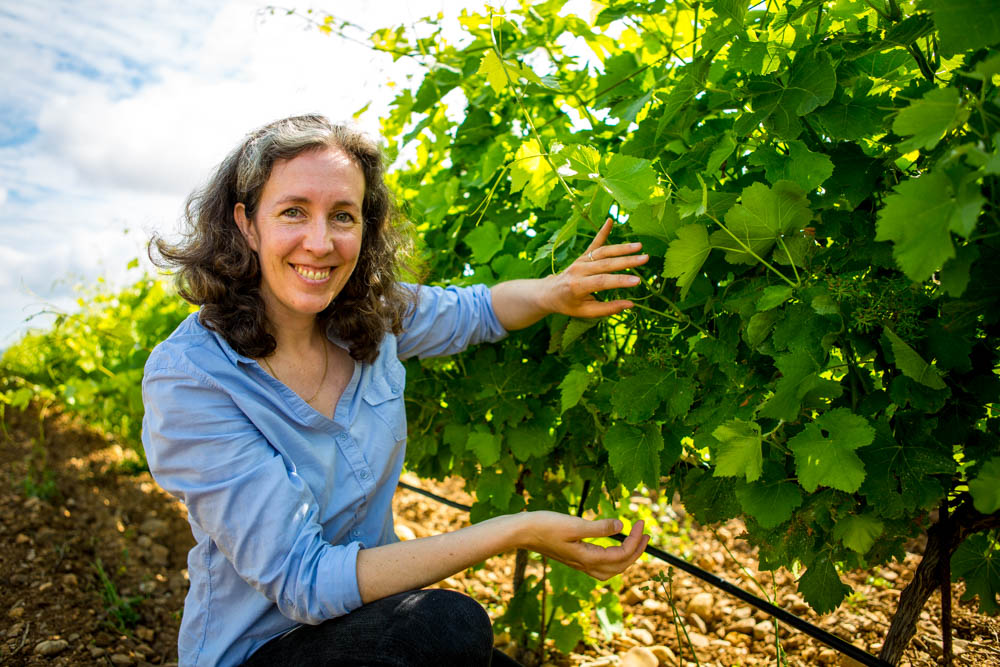
The Importance of the first irrigation
Aurélie Mercier, Technical Director at Domaine Cazes (Advini group) in Roussillon, emphasizes that irrigation decisions must be based on multiple sources of information. “ “With water restrictions and drought conditions persisting for the past three years, we cannot afford to waste a single drop. To ensure efficient irrigation, we integrate a variety of tools and methods, including Vintel®’s decision support system (DSS), the pressure chamber, soil tensiometers, and visual indicators such as shoot length and apex monitoring. The key is cross-referencing these data sources to make well-informed decisions.”
At Domaine Cazes, where 100 hectares out of 300 are irrigated, the timing of the first irrigation is crucial. In 2024, for the first time, irrigation was triggered before budbreak due to historically low soil water reserves. “The soil was completely dry, no sap was dripping from pruning cuts and growth was blocked. “ . This lack of soil moisture can cause harmful conditions known as “delayed spring growth“, where dehydrated dormant buds struggle to reconnect with the vine’s vascular system. Without sufficient sap flow to repair winter embolisms and rehydrate buds, shoots may experience stunted growth, wilting, and, in severe cases, fruit abortion. By irrigating before budbreak, Domaine Cazes aimed to restore soil moisture early enough to prevent these issues and support healthy vine development.
“In 2024, for the first time, irrigation was triggered before budbreak. The soil was completely dry, no sap was dripping from pruning cuts and growth was blocked. “
With increasing restrictions on water use, precision becomes even more critical. “Due to water restrictions we can irrigate only five hectares per day, meaning the same plot will not receive irrigation more than once in 2-3 weeks. This means that we need to adjust our irrigation frequency and volume based on what is practically feasible and optimize our choices” says Mrs. Mercier.
The Role of Decision Support Systems Tools like Vintel® provide a significant advantage by modeling soil water availability, vine stress, and helping viticulturists anticipate depletion trends. “One of the most valuable features of Vintel® is its ability to track the dynamics of water loss in the soil’s Available Water Content (AWC). This allows us to plan and avoid critical stress levels,” explains Mercier.
“Due to irrigation restrictions, we can irrigate only five hectares per day, meaning the same plot will not receive irrigation more than once in 2-3 weeks. This means that we need to adjust our irrigation frequency and volume based on what is practically feasible”.
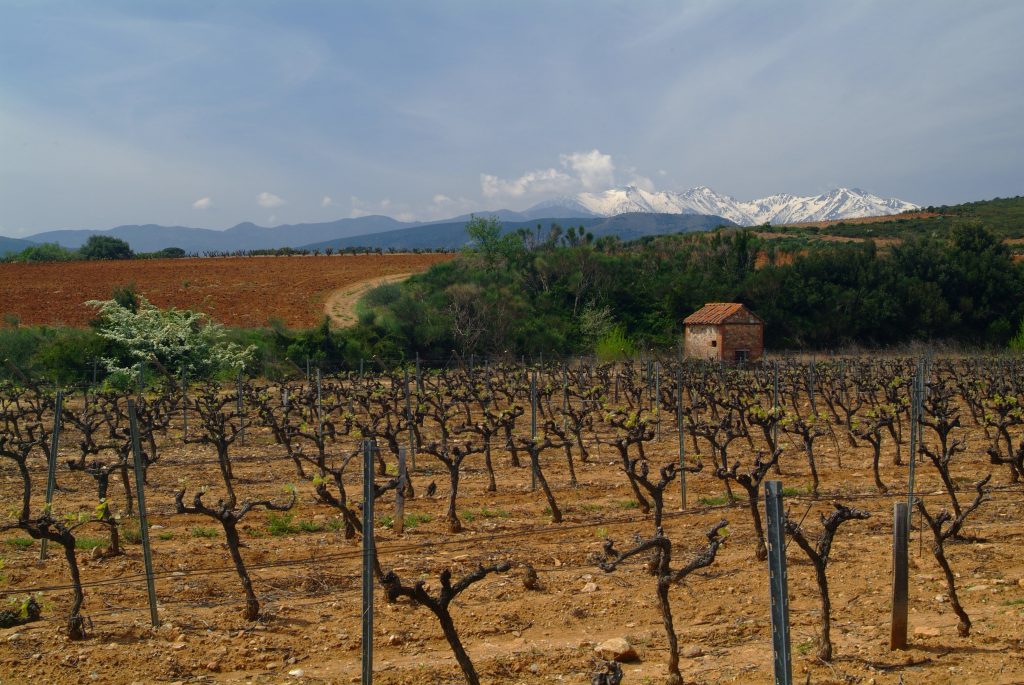
The key to a successful strategy
By comparing data from Vintel® with real-time field measurements, Domaine Cazes has been able to refine its irrigation strategy to meet both wine production goals and quality standards, even in challenging years. Whether producing structured red wines or fresh white wines, fine-tuning irrigation ensures the right balance between vine water stress and grape quality, allowing the domaine to maintain both high-quality yields and steady production despite the tough conditions.
For those starting with decision support system and Vintel®, Aurélie Mercier advises comparing multiple data sources at the beginning and calibrating models using pressure chambers to adjust parameters to match simulations in each reference plot, ensuring the accuracy of future predictions.
“With Vintel®, I can monitor changes in soil moisture in real time, which helps me anticipate each plot’s water needs and plan interventions more effectively”.
In the face of increasing climate unpredictability, leveraging technology and real-time monitoring is no longer an option—it is a necessity. Vintel® provides the insights needed to navigate these challenges, ensuring that each drop of water contributes to both vineyard sustainability and wine quality.
Contact us now and ask for a demo!

Vineyard irrigation is a necessary part of vineyard management in dry wine growing regions where winegrowers completely or partly rely on irrigation water. With irrigation, winegrowers can control vine growth and grape quantity and quality. This is because water availability is a crucial factor affecting plant physiology and the quality of grapes. In dry production areas such as the Mediterranean region, the use of irrigation is thus a fundamental practice which grants the economic sustainability of viticulture.
Vineyard irrigation and climate change
In addition to areas traditionally considered as “dry” during the growing season, new regions are increasingly showing the need of irrigation. The climate change underway is leading to an increase in temperatures and a reduction in rainfall in the summer period, increasing water stress in vineyards, which could potentially undermine both yield and grape quality. These changes will make it necessary to implement irrigation in viticultural areas for which drought is a new phenomenon. The increase in temperatures will also cause a reduction in the water resources available, making it necessary to decrease the water footprint by using deficit irrigation strategies which optimize water use efficiency.
Such practices are already routinely adopted in viticultural areas with limited rainfall throughout the production season. Indeed, irrigating with small amounts of water has the effect of reducing growth and canopy size, limiting transpiration losses and therefore maintaining production and quality at reduced water inputs. However, particular care must be exerted, as the line between moderate and excessive water stress is very thin and crossing it might lead to incomplete/unbalanced ripening and deteriorate the polyphenolic and aromatic profile of wines. For this reason, a deficit irrigation strategy needs to be carefully planned and its effects need to be continuously monitored.
What is deficit irrigation in viticulture
Deficit irrigation maximizes the efficiency of water use, by concentrating limited seasonal water supplies to drought-sensitive crop growth stages. Outside these periods, irrigation is limited or even unnecessary if rainfall provides a minimum supply of water. Water application is therefore inferior to the actual water needed for maximum growth. While this inevitably results in plant drought stress and some production loss, it maximizes productivity for a given amount of water and stabilizes yields.
For grapevine, the effect of water deficit on fruit growth varies according to the period during which it is applied. Research shows that it is greater when it is applied during berry formation (between flowering and veraison) when can limit cell division and expansion and decrease the final size of berries and total yield. Similarly, a stress applied at the time of flower bud differentiation can negatively impact fruitfulness and production the following year.
Fruit quality is also sensitive to water stress, depending on its levels. Whereas moderate stress can increase sugar concentration and anthocyanins and phenol compounds in berries (thereby enhancing wine color and aroma), excessive stress and high temperatures could cause a photosynthetic limitation reducing the accumulation of sugar. Finally, water stress can impact on acid content in grapes in interaction with temperature. This effect is particularly pronounced after veraison, when rapid acid degradation due to high temperatures and water stress can result in dull wines lacking freshness and crispness.
Using Vintel for deficit irrigation: an experimental study during the Italian drought of 2022
It is now clear that under climate change, the key to viticultural sustainability will be the adoption of smarter and more precise water management strategies. For that, it is crucial to have a complete vision of the water status of vineyards and its evolution over the production season. New technologies provide us with different tools that can support informed irrigation choices, and optimize water use during drought. One of these tools is the irrigation DSS Vintel, which uses accurate plant-soil models to simulate vineyard water status, and give irrigation recommendations, day by day according to production objectives.
A recent study by the university of Udine, Italy, has highlighted that Vintel can indeed help plan and optimize irrigation to preserve production and quality in areas hit by summer drought, which is becoming more and more frequent. Vintel has been chosen by the University of Udine within the European project “Aquavitis” as a tool to conduct trials on the effects of water availability and the impacts of climate change on the vineyards of the Friuli Venezia Giulia region, in North-Eastern Italy.
Indeed, in the spring-summer of 2022 Northern Italy has experienced one of the worst droughts in the last 70 years, with precipitations reaching a historical minimum and rivers running almost dry. The drought has resulted in water restrictions and has hit hard the agricultural sector, as low river levels made irrigation difficult.
Paolo Sivilotti, the researcher who supervised the trials explains : ” The test was conducted in 2021 and 2022 near Udine. It analysed the response of Pinot gris, a typical variety from the region, to three different water treatments: no stress, moderately stressed, severely stressed. ” To monitor and maintain these water stress levels over the season, Mr. Sivilotti used Vintel, which simulates predawn water potential as an indicator of plant water status.
Using Vintel, water potential was mantained at:
- No stress : -0.2 MPa over the whole season
- Moderate stress : -0.35 MPa between flowering and harvest
- Severe stress : -055 MPa between flowering and harvest
” What was really interesting was to see whether a deficit irrigation strategy could help optimize water use and what level of stress should be maintained after flowering to ensure a satisfactory yield and grape quality. The DSS Vintel was the ideal tool to conduct this study because its models do not just simulate soil moisture but provide a direct estimate of the effect that soil water shortage has on vine water status. The pressure chamber measures made during the growing seasons confirmed the accuracy of simulations, making any DSS adjustment unnecessary.”
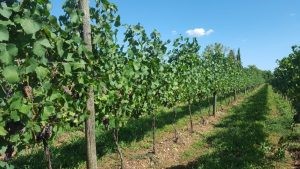
No water stress
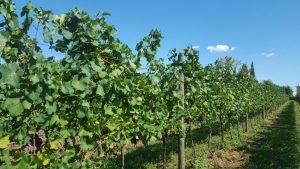
Moderate water stress
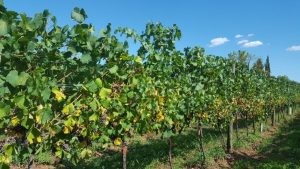
Severe water stress
The results show that “the moderately stressed regime allowed to save 31% and 50% of irrigation water in 2021 and 2022 with modest impacts on yield and physiology, and without any repercussions on quality“. Indeed, a wine tasting panel has tried the wines produced in 2021, and no difference between the stressed and non-stressed wines has been remarked.
“Obviously more studies are needed to assess the best deficit irrigation strategies in different viticultural contexts.”
However, results confirm that under climate change, precision deficit irrigation can be a valuable strategy preserving production, quality and decreasing the water footprint of viticulture.
“Not only, during extreme events like the one that hit Northern Italy this summer, deficit irrigation might be the only possible alternative, if water restrictions are put in place or if water becomes too expensive.” In this context, tools like Vintel are precious allies to vine growers in the creation a climate resilient, more sustainable viticulture.
Contact us now and ask for a demo!

Managing water stress in vineyards is crucial to ensuring vineyard health and producing high-quality grapes. Severe water stress can lead to a reduction in berry size, a drop in sugar content and a deterioration in fruit quality. Early detection enables winegrowers to adjust their irrigation strategies, avoiding irreversible damage while optimising the use of water resources.
Methods of detecting water stress
Direct visual observation
Direct visual observation of the canopy is a simple method for identifying water stress in vines. For example, the apex technique involves monitoring the growth of the shoot tips. If growth stops or the young shoots show signs of wilting, this is an indication of water stress. However, these qualitative methods often only detect stress only at advanced stages, making it more difficult to prevent damage.
Illustrations of apex methods:

Source : Observation of vine shoot growth: a simple and operational decision-making tool for monitoring the water status of vines in the vineyard (2023) Léo Pichon, Cécile Laurent, Jean-Christophe Payan, Bruno Tisseyre (OenoOne 57)
Measuring leaf water potential
Measuring leaf water potential is a more accurate quantitative approach to assessing the water status of vines. By assessing the pressure required to extract water from the leaves, winegrowers can determine whether the vines are receiving adequate hydration or are under drought stress. This technique uses a pressure chamber that applies controlled pressure to a leaf or small shoot. As the pressure increases, water is expelled from the cut section of the leaf, and the pressure at which the water appears can be used to measure the hydric potential of the leaf.
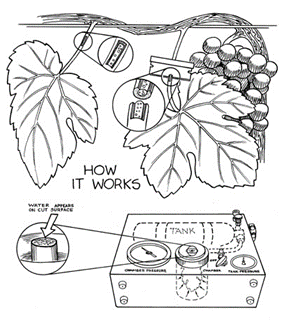
Variability of water potential
Leaf water potential varies throughout the day key measurements corresponding to precise moments:
Pre-dawn water potential (or base potential) : measured before sunrise, when when plant and soil water potential are in equilibrium , this parameter is a crucial reference for assessing water availability in the soil.
Midday water potential: measured during the hottest part of the day, this reflects the plant’s response to atmospheric demands, enabling us to assess the way in which the vine manages water stress on a daily basis.
Stem water potential: assessed by enclosing a shaded leaf in a bag to temporarily stop transpiration, this test indicates the vine’s internal water status, independently of external evaporative conditions.
Of these measurements, pre-dawn water potential is often considered the most reliable for monitoring the vine’s actual water status. It provides an assessment of the internal hydration of plants, independently of immediate atmospheric conditions, and is therefore widely used to guide irrigation management in vineyards.
Monitoring water stress, a key to sustainable, high-quality production
Monitoring water stress is essential for maintaining healthy vines and ensuring the production of quality grapes. By combining visual observation methods with precise measurements of leaf water potential, winegrowers can make informed decisions about irrigation, protecting their crops from the harmful effects of drought and optimising water use.
In addition to these observations and measurements, the Vintel® Decision Support Tool models soil water content and basic leaf potential throughout the wine-growing season, helping advisers and wine-growers to monitor the water content of their vineyards.
Contact us now and ask for a demo!

Wine quality depends on the effective management of alcoholic fermentation, which is a key process carried out by the yeast Saccharomyces cerevisiae in the musts. One of the key factors in successful fermentation is the availability of yeast-available nitrogen (YAN). If the musts lack sufficient YAN, fermentation can be delayed or stopped altogether, resulting in the formation of undesirable compounds that alter the wine’s aroma. To avoid these problems, an adequate level of YAN is crucial.
What is YAN ?
To convert grape sugars into alcohol efficiently, yeasts need sufficient quantities of assimilable nitrogen, mainly in the form of ammonium and amino acids… Among amino acids, some, such as proline, are not assimilable by yeast. This is because Saccharomyces cerevisiae, unlike other yeasts, lacks external proteases (enzymes that digest proteins) and therefore cannot hydrolyze peptides and proteins to extract amino acids. Therefore, YAN includes only ammonium ions (NH4+), free amino acids, and some peptides, which means that assimilable nitrogen can represent less than 50% of the total nitrogen.
Nitrogen requirements of yeast during fermentation
Scientific studies show that a YAN level above 180-200 mg/L is optimal for ensuring regular and complete fermentation. Lower levels can lead to incomplete fermentation, leaving residual sugars and producing wines of lower quality. According to the Institut Français de la Vigne et du Vin (IFV), the minimum YAN level in a should be at least 140 mg/L, including 50 mg/L in the form of ammonia, toto prevent fermentation from stalling.
Furthermore, YAN also influences the aromatic profile of the wine. The production of aromatic compounds, particularly esters, largely depends on the amount of assimilable nitrogen available to the yeast. Generally, the initial concentration of assimilable nitrogen in the must is directly related to the quantity of aromatic compounds produced during alcoholic fermentation
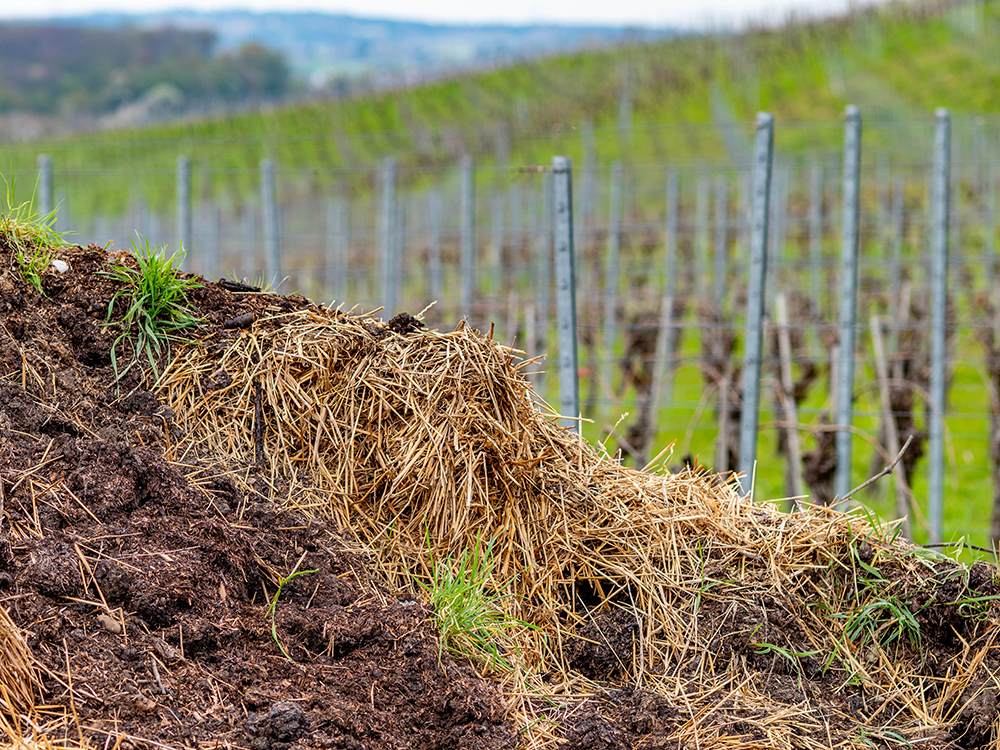
Nitrogen fertilisation to improve must quality
YAN level is therefore a key indicator for winegrowers seeking to optimise the quality of their musts. Proper nitrogen fertilisation increases the nitrogen content of the berries. For example, trials carried out by the IFV between 2005 and 2009 showed that urea-based foliar fertilisation can boost the nitrogen content of berries by 50% to 100%, depending on the dose applied.
If musts are low in nitrogen, adding YAN as a nutrient during fermentation is an option. However, this method can result in different aromatic profiles compared to wines from vineyards with adequate nitrogen fertilization.
For example, a recent study on Chardonnay revealed that, while adding nitrogen in the form of diammonium phosphate or organic nitrogen during fermentation can achieve fermentation kinetics similar to those from vineyard fertilization, they produce wines with less pronounced tropical fruit aromas.
In summary, while cellar additions of nitrogen are effective for completing fermentation, conducting a balanced fertilization in the vineyard is preferred as it enhances the aromatic characteristics of the wine.
Using decision-support tools to control nitrogen nutrition
Decision-aid tools such as Vintel® are particularly useful for improving nitrogen nutrition in vineyards and, consequently, the fermentation process. These tools enable winegrowers to forecast the nitrogen requirements of their vines based on environmental conditions (soil, weather, cover crops) and the specific characteristics of plants (phenological stage, growth, target yield). Thanks to this data, winegrowers can fine-tune their fertilisation practices, optimising nitrogen uptake and, ultimately, the quality of their musts, ensuring that they ferment evenly to produce quality wines.
In short, precise fertilisation adapted to each vineyard is essential for producing high quality grapes and ensuring optimal fermentation. Effective management of assimilable nitrogen helps to prevent fermentation issues and produce top wines.
Contact us now and ask for a demo!


